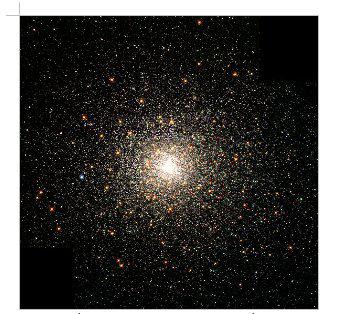But the search is on to narrow it down and a new paper has computationally set limits to the properties of one of the particles which might be identified as dark matter: axions. Due to the high temperature inside stars, photons can turn into axions that escape to the exterior, carrying energy with them.
The simulation indicates that the emission of axions can significantly diminish the time for the central combustion of helium, the so called HB (Horizontal Branch) phase: the energy taken by axions is compensated with the energy provided by nuclear combustion, which leads to a much faster consumption of helium.

Globular clusters consist of ancient star populations, which contain stars in different phases of evolution. Credit: NASA
"This loss of energy can have consequences, whether they are observable or not, in some phases of stellar evolution," says graduate student Adrián Ayala of the FQM Stelar Evolution and Nucleosynthesis research group at University of Granada. "In our research, we have conducted numerical simulations (by computer) of the evolution of a star, since its birth until it exhausts all the hydrogen first and then the helium in its interior, including the processes that produce axions."
"Using this influence over the timing that features in this sort of evolution we can determine the emission of axions, since a high emission rate means a quick HB phase, thus diminishing the possibility of watching stars in this phase," says professor Immaculada Domínguez.
Maximum axion emission rate
The high quality observations of globular clusters allows for calibrating the results of the numerical observations conducted in this project with the actual data. "By comparing the amount of stars observed in HB phase with the amount of stars watched in a different phase not affected by axions (such as the so called RGB, Red Giant Branch, phase) we have made an estimation about the maximum axion emission rate," the authors write.
The production of axions relies on the constant coupling of axion-photon which characterizes the interaction between axion and photons. "We have obtained a maximum limit for this constant which is more restrictive than those established so far, both theoretically and through experiments."
The authors of this research point out that the accuracy in the determination of the coupling constant through the method used "critically depends on the accuracy with which the initial helium content within the stars in the globular cluster can be estimated."
Published in Physical Review Letters.






Comments